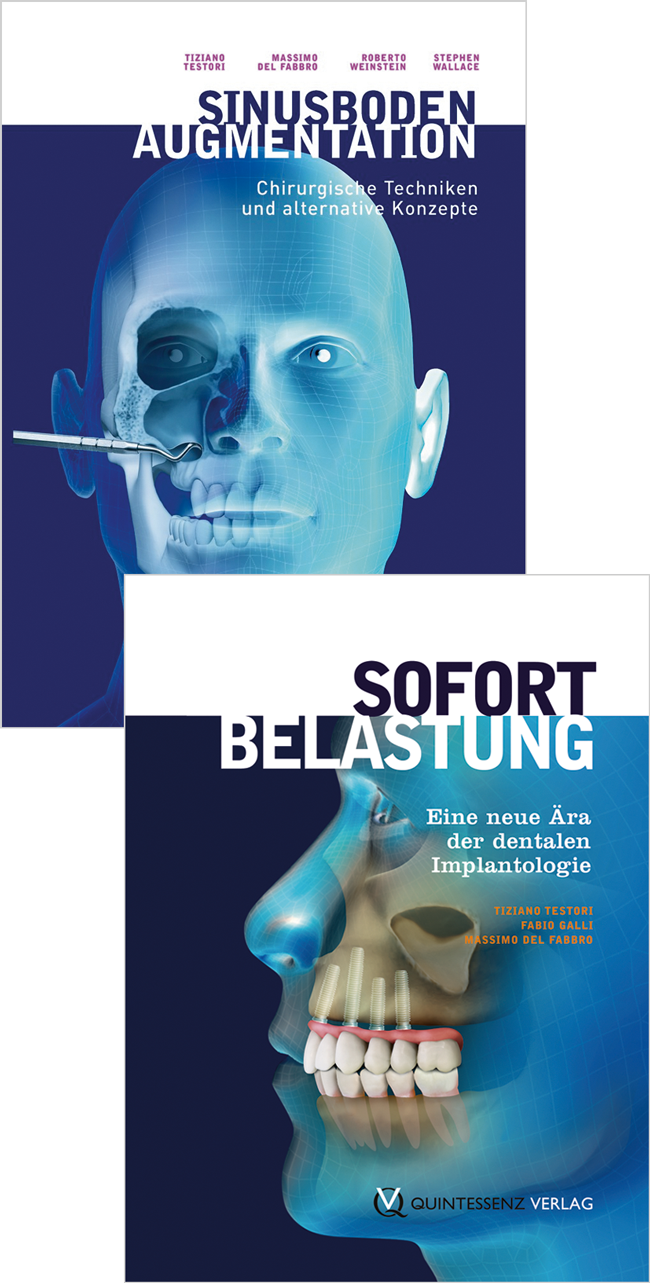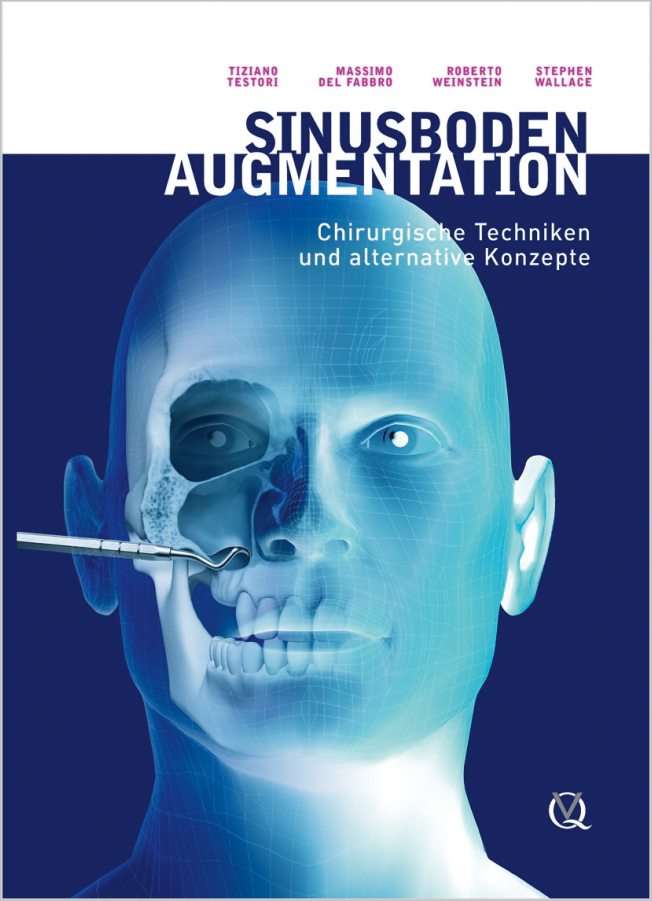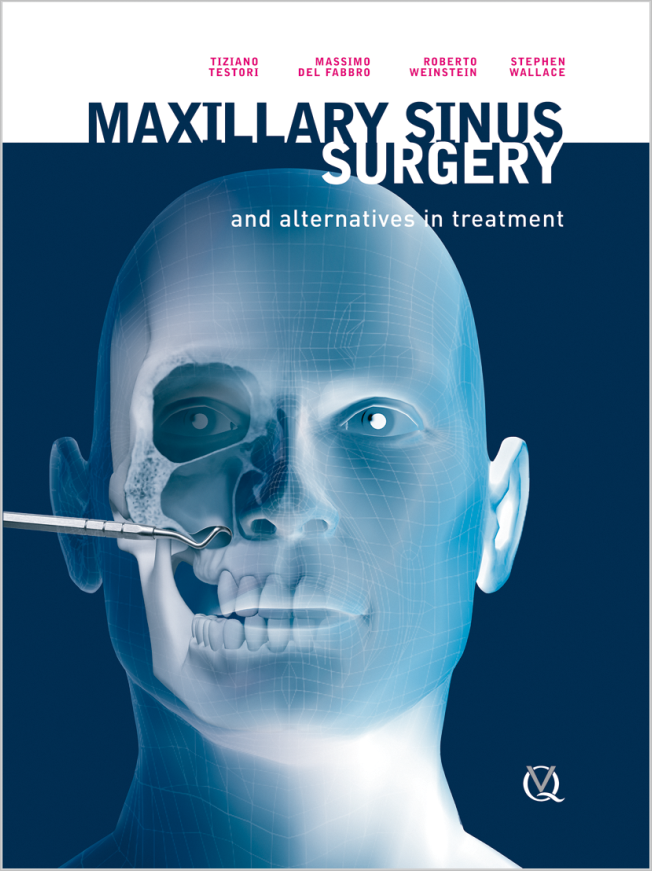The International Journal of Oral & Maxillofacial Implants, 3/2020
DOI: 10.11607/jomi.8034, PubMed-ID: 32406663Seiten: 631-638, Sprache: EnglischTestori, Tiziano / Tavelli, Lorenzo / Yu, Shan-Huey / Scaini, Riccardo / Darnahal, Alireza / Wallace, Stephen S. / Wang, Hom-LayMaxillary sinus augmentation is a procedure commonly performed in patients in need of posterior maxillary implants with limited vertical ridge height and sinus pneumatization. However, minimal information has been presented to evaluate the complexity of the sinus elevation procedure via a lateral window approach based on patient examination, including extraoral findings, anatomical factors, and the possible influence from the surgeon's experience. Therefore, this article presents a new scheme of maxillary sinus floor elevation difficulty score based on comprehensive patient- and surgicalrelated factors. The proposed scoring tool aims to aid surgeons in performing a comprehensive presurgical evaluation prior to the lateral wall sinus augmentation surgery and also enhance communication between clinicians and patients regarding the complexity of the case.
Schlagwörter: intraoperative complications, maxillary sinus, postoperative complications, risk factors, sinus floor augmentation
International Journal of Periodontics & Restorative Dentistry, 4/2019
DOI: 10.11607/prd.3865, PubMed-ID: 31226194Seiten: 545-551, Sprache: EnglischHameed, Sabina / Bakhshalian, Neema / Alwazan, Essa / Wallace, Stephen S. / Zadeh, Homayoun H.This retrospective study investigated the changes in the maxillary sinus floor and alveolar crest following extraction of maxillary molars. Pre- and postextraction cone beam computed tomography scans of 23 patients were analyzed. Paired-sample t tests compared pre- and postextraction measurements, and independent-sample t tests were utilized for intergroup comparisons. Pearson correlation was used to assess the association between the measured variables and the outcome measures. The mean alveolar bone height reduction was 3.42 ± 2.40 mm and the alveolar crest loss was 3.07 ± 2.53 mm. The maxillary sinus floor position shifted coronally by a mean of 0.47 ± 0.32 mm. Approximately 88% of postextraction changes in alveolar bone height were due to alveolar crest changes, compared to 12% due to changes in the sinus floor position. The results of this study challenge the commonly held concept of extensive postextraction maxillary sinus floor alterations leading to sinus pneumatization.
International Journal of Periodontics & Restorative Dentistry, 7/2014
SupplementDOI: 10.11607/prd.2139, PubMed-ID: 24956091Seiten: 50-57, Sprache: EnglischNevins, Myron / Cappetta, Emil G. / Cullum, Dan / Khang, Wahn / Misch, Craig / Ricchetti, Paul / Sclar, Anthony / Wallace, Stephen S. / Ho, Daniel Kuan-Te / Kim, David M.Conventional dentoalveolar osseous augmentation procedures for creating bone volume for dental implant placement often involve the use of grafting materials with or without barrier membranes to foster selective cell and tissue repopulation. A study was conducted to determine the efficacy of equine particulate bone (Equimatrix, Osteohealth) to augment the creation of new bone and preserve the volume of bone at extraction sites for the purpose of placing an implant in an optimal position for restoration. Clinical and histologic evidence supported the suitability of equine particulate bone for extraction site augmentation that allowed dental implant placement after a 6-month healing period.
International Journal of Periodontics & Restorative Dentistry, 6/2013
DOI: 10.11607/prd.1288, PubMed-ID: 24116362Seiten: 773-783, Sprache: EnglischFabbro, Massimo Del / Wallace, Stephen S. / Testori, TizianoThe predictability of maxillary sinus augmentation has been extensively reported. Procedural outcomes, most often measured as implant survival rates, have customarily used inclusion criteria that included a minimum 1-year loading time. The inclusion criteria of this review extended the minimum postloading evaluation to 3 years to determine if the previously reported short-term survival rates are maintained. An electronic search of the literature was performed and retrieved articles were screened using specific inclusion criteria, paramount of which was a minimum of 3 years of follow-up. The search revealed 18 articles for the lateral window approach (6,500 implants in 2,149 patients) and 7 for the transalveolar approach (1,257 implants in 704 patients). Overall, implant survival after a minimum of 3 years loading was 93.7% and 97.2% for the lateral window and transalveolar approaches, respectively. Of importance is the fact that 80% of failures occurred within the first year and 93.1% of the failures occurred within 3 years. The risk of implant failure after 3 years can now be directly calculated as the overall risk of failure after 3 years (6.3%) × the incidence of late failures (6.9%), thus equaling 0.43%. This review discredits the theory that studies of a lower level of evidence report inflated results when compared with prospective randomized controlled clinical trials.
International Journal of Periodontics & Restorative Dentistry, 4/2013
DOI: 10.11607/prd.1423, PubMed-ID: 23820706Seiten: 467-475, Sprache: EnglischTestori, Tiziano / Wallace, Stephen S. / Trisi, Paolo / Capelli, Matteo / Zuffetti, Francesco / Del Fabbro, MassimoThe purpose of this study was a histomorphometric comparison of vital bone formation following maxillary sinus augmentation with two different particle sizes of anorganic bovine bone matrix (ABBM). Bilateral sinus floor augmentations were performed in 13 patients. Trephine bone cores were taken from the lateral window areas of 11 patients 6 to 8 months after augmentation for histologic and histomorphometric analysis. Bone samples from both the large and small particle size groups showed evidence of vital bone formation similar to that seen in previous studies, confirming the osteoconductivity of ABBM. Significant bone bridging was seen creating new trabeculae composed of the newly formed bone and residual ABBM particles. Histologic evaluation revealed the newly formed bone to be mostly woven bone with some remodeling to lamellar bone. Osteocytes were seen within the newly formed bone as well as osteoblast seams with recently formed osteoid. Isolated osteoclasts were observed on the ABBM surfaces. Vital bone formation (primary outcome measure) was more extensive in the large particle grafts compared with the small particle grafts (26.77% ± 9.63% vs 18.77% ± 4.74%, respectively). The histologic results reaffirm the osteoconductive ability of ABBM when used as the sole grafting material in maxillary sinus augmentation. The histomorphometric results at 6 to 8 months revealed a statistically significant increase (P = .02) in vital bone formation when the larger particle size was used. Additional studies should be performed to confirm these results.
The International Journal of Oral & Maxillofacial Implants, 1/2011
PubMed-ID: 21365047Seiten: 123-131, Sprache: EnglischGonshor, Aron / McAllister, Bradley S. / Wallace, Stephen S. / Prasad, HariPurpose: Long-term success of dental implants has been demonstrated when placed simultaneously with or after a sinus augmentation procedure. However, optimal bone formation can be from 6 to 9 months or longer with grafting materials other than autogenous bone. For this reason, there is interest in any surgical technique that does not require autogenous bone harvesting, yet results in sufficient bone formation within a relatively short time frame.
Materials and Methods: This study evaluated and compared bone formation following sinus-augmentation procedures using either an allograft cellular bone matrix (ACBM), containing native mesenchymal stem cells and osteoprogenitors, or conventional allograft (CA). Results: Histomorphometric analysis of the ACBM grafts revealed average vital bone content of 32.5% ± 6.8% to residual graft content of 4.9% ± 2.4% for the 21 sinuses in the study, at an average healing period of 3.7 ± 0.6 months.
Results for the CA, in the same time frame, were average vital bone content of 18.3% ± 10.6% to residual graft content of 25.8% ± 13.4%. A comparison of ACBM and CA grafts, for both vital and residual bone contents, showed P values of .003 and .002, respectively, indicating a statistically significant difference between the groups.
Conclusion: The high percentage of vital bone content, after a relatively short healing phase, may encourage a more rapid initiation of implant placement or restoration when a cellular grafting approach is considered.
Schlagwörter: bone regeneration, osteoblasts, ridge augmentation, stem cells, tissue engineering
International Journal of Periodontics & Restorative Dentistry, 2/2010
PubMed-ID: 20228973Seiten: 139-149, Sprache: EnglischTarnow, Dennis P. / Wallace, Stephen S. / Testori, Tiziano / Froum, Stuart J. / Motroni, Alessandro / Prasad, Hari S.The objective of the following case reports was to assess whether mineralized bone replacement grafts (eg, xenografts and allografts) could be added to recombinant human bone morphogenetic protein-2/acellular collagen sponge (rhBMP-2/ACS) in an effective manner that would: (1) reduce the graft shrinkage observed when using rhBMP-2/ACS alone, (2) reduce the volume and dose of rhBMP-2 required, and (3) preserve the osteoinductivity that rhBMP- 2/ACS has shown when used alone. The primary outcome measures were histomorphometric analysis of vital bone production and analysis of serial computed tomographic scans to determine changes in bone graft density and stability. Over the 6-month course of this investigation, bone graft densities tended to increase (moreso with the xenograft than the allograft). The increased density in allograft cases was likely the result of both compression of the mineralized bone replacement graft and vital bone formation, seen histologically. Loss of volume was greater with the four-sponge dose than the two-sponge dose because of compression and resorption of the sponges. Vital bone formation in the allograft cases ranged from 36% to 53% but, because of the small sample size, it was not possible to determine any significant difference between the 5.6 mL (four-sponge) dose and the 2.8 mL (two-sponge) dose. Histology revealed robust new woven bone formation with only minimal traces of residual allograft, which appeared to have undergone accelerated remodeling or rhBMP-2-mediated resorption.
International Journal of Periodontics & Restorative Dentistry, 3/2008
PubMed-ID: 18605603Seiten: 273-281, Sprache: EnglischFroum, Stuart J. / Wallace, Stephen S. / Cho, Sang-Choon / Elian, Nicolas / Tarnow, Dennis P.This blinded, randomized, controlled pilot investigation is the first to histomorphometrically compare vital bone formation following bilateral sinus grafting with a biphasic calcium phosphate (BCP) (Straumann Bone Ceramic) to an anorganic bovine bone matrix (ABBM) (Bio-Oss) 6 to 8 months following graft placement. Twelve patients were selected. Following elevation of the lateral sinus walls, one material was placed in the right sinus and the other material was placed in the left sinus, as determined by randomization. Six to 8 months after grafting (with the same time frame used for each patient), a trephine core was taken from the grafted area and sent for histomorphometric analysis. Cores were obtained from 21 healed sinuses in 12 patients. Nine patients provided bilateral cores. Histomorphometric analysis of 10 BCP cores and 11 ABBM cores revealed an average vital bone content of 28.35% and 22.27%, respectively. The average percentage of residual graft particles was 28.4% in the BCP cores and 26.0% in the ABBM cores. The difference in vital bone formation was not significantly different (n = 9 patients, paired t test) between bilateral sinuses treated with the BCP and those treated with the ABBM. Histologically, both materials appeared to be osteoconductive and support new bone formation. Future studies are needed to confirm the ability of this regenerated bone to support dental implant maintenance over time.
International Journal of Periodontics & Restorative Dentistry, 1/2008
PubMed-ID: 18351198Seiten: 9-17, Sprache: EnglischTestori, Tiziano / Wallace, Stephen S. / Del Fabbro, Massimo / Taschieri, Silvio / Trisi, Paolo / Capelli, Matteo / Weinstein, Roberto L.The most frequent intraoperative complication with sinus elevation is perforation of the schneiderian membrane. In most instances, the repair of this perforation is necessary to contain particulate grafting material and complete the procedure. New techniques are presented here for the management of large perforations of the schneiderian membrane. A bioabsorbable collagen membrane is stabilized outside the antrostomy and then folded inward to create either a new superior wall that can obliterate a large perforation or a "pouch" that can completely contain the particulate material. This can make it possible to complete a procedure that otherwise may have had to be aborted by preventing dispersion of the particulate graft within the sinus cavity. Clinical cases are shown, along with follow-up at 6 to 9 months, demonstrating histologic and/or radiographic evidence of success, continued sinus health, and superior vital bone formation. The authors have used this technique on 20 consecutive patients without experiencing any procedural failures.
International Journal of Periodontics & Restorative Dentistry, 5/2007
PubMed-ID: 17990437Seiten: 413-419, Sprache: EnglischWallace, Stephen S. / Mazor, Ziv / Froum, Stuart J. / Cho, Sang-Choon / Tarnow, Dennis P.The lateral window sinus elevation procedure has become a routine and highly successful preprosthetic procedure that is used to increase bone volume in the posterior maxilla for the placement of dental implants. Many surgical techniques have been proposed that provide access to the maxillary sinus through the lateral wall to allow for elevation of the sinus membrane. Among these are the multiple variations of the hinge and complete osteotomy techniques, which make use of rotary cutting instruments for the antrostomy. The most common intraoperative complication with these surgical approaches is perforation of the schneiderian membrane, with perforation rates of 14% to 56% reported in the literature. In most instances, perforation occurs either while using rotary instruments to make the window or when using hand instruments to gain initial access to begin the elevation of the membrane from the sinus walls. This article presents an alternative approach that uses a piezoelectric instrument for the sinus elevation procedure. Although new to the United States, this approach has been used successfully in Europe for many years. The membrane perforation rate in this series of 100 consecutive cases using the piezoelectric technique has been reduced from the average reported rate of 30% with rotary instrumentation to 7%. Furthermore, all perforations with the piezoelectric technique occurred during the hand instrumentation phase and not with the piezoelectric inserts.







